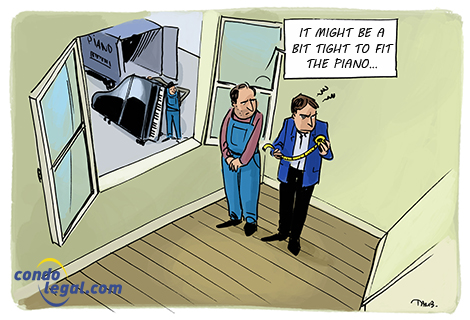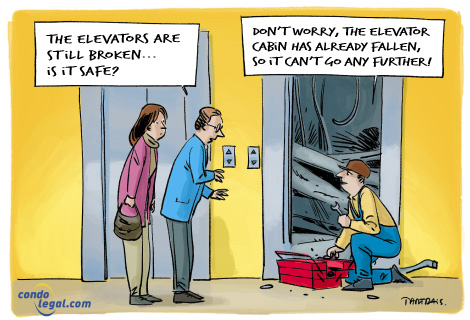
Relocations and move-ins involve going through the common portions of the building to transport furniture, boxes and other personal belongings. These operations could turn into a real mess or nightmare if, in a co-ownership (condominium), the framework for managing them has not been clearly established. While certain provisions of the declaration of co-ownership are universal on this issue, nothing prevents a syndicate of co-owners from improving its content in order to adapt them to its own reality.
Declaration of co-ownership
This document generally sets out various prohibitions, sanctions, conditions or precautions to be respected during relocations and move-ins; it may provide:
Security deposit
If damages are done to the common portions during any of the operations of move-ins or relocations, the board of directors is generally authorized to use all or part of the security deposit paid by the co-owner as compensation to repair such damages; however, if the damages exceed the amount of the deposit, the syndicate retains all its recourses. On the other hand, if there are no damages or if a residual amount remains after compensation, the board of directors shall remit that amount or the residue thereof.
Disputes during a move
Failure to notify the syndicate that a co-owner or tenant will be moving into the building could be a source of litigation; in fact, many will not appreciate when a new occupant shows up with a moving truck on a nice saturday morning without the whole procedure having been announced beforehand. Most directors will want to be notified if a co-owner decides to rent his apartment to a third party or if his tenant changes identity.
Newcomers may be denied access to the building until the owner of the apartment is contacted; for example, the latter will have to confirm that a tenant has been allowed to move in. It is important to note that a syndicate has a duty to ensure the security of the premises; unknown and unannounced tenants can create a sense of insecurity.
Co-ownership subletting
In addition, tenants of a co-ownership apartment may leave before the end of the lease and sublet the unit to someone else; this is another area where things could get more difficult and will often result in disagreement expressed by several directors who will not approve this type of manoeuvre which could lead to a multiplication of keys giving access to a building.
Notification of a new occupant to the syndicate
Co-owners who rent or lend their private portion free of charge must notify the syndicate within 15 days; they must also reveal the identity of the tenant or occupant and so, even if the rental or occupation only lasts a few days, they must also indicate the term of the lease or right of occupancy as well as the date on which they gave the tenant or occupant a copy of the by-laws of the immovable (including any amendments).
Section 1057 of the Civil Code of Québec stipulates that once a copy of the by-laws of the immovable have been delivered by the co-owner or by the syndicate, that document can be used against the tenant or occupant; once the by-laws of the building have been communicated to the tenant or occupant, the latter is bound to respect them in their entirety.
 WHAT YOU SHOULD KNOW! In most buildings, the mobilization of elevators is generally governed by rules. A designated person will make sure to install carpets and protective covers in the cabin to prevent a new occupant from damaging the interior. In some cases, the move may not go through the main entrance of a building but rather through its underground parking lot.
WHAT YOU SHOULD KNOW! In most buildings, the mobilization of elevators is generally governed by rules. A designated person will make sure to install carpets and protective covers in the cabin to prevent a new occupant from damaging the interior. In some cases, the move may not go through the main entrance of a building but rather through its underground parking lot.
 WHAT TO KEEP IN MIND: If it is a co-ownership whose management is closely monitored and where the building by-laws have been improved, a move could be accompanied by a clause that provides for costs; in other words, the co-owner/landlord or the newcomers will have to pay a deposit which will be used to pay personnel who will take the necessary precautions.
WHAT TO KEEP IN MIND: If it is a co-ownership whose management is closely monitored and where the building by-laws have been improved, a move could be accompanied by a clause that provides for costs; in other words, the co-owner/landlord or the newcomers will have to pay a deposit which will be used to pay personnel who will take the necessary precautions.
 WARNING! If damages are caused to the common portions of the building, the co-owner will have to pay for the repairs. Unless otherwise stipulated, the amount of the security deposit does not constitute a limit to the co-owner's liability.
WARNING! If damages are caused to the common portions of the building, the co-owner will have to pay for the repairs. Unless otherwise stipulated, the amount of the security deposit does not constitute a limit to the co-owner's liability.


